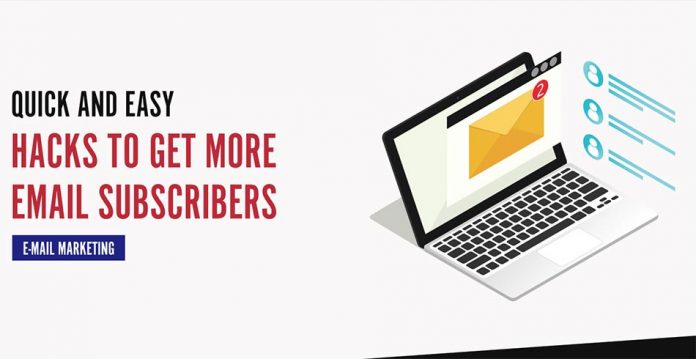Table of Contents
Increasing your number of Email Subscribers can be tricky, especially if your business is new or you only have limited time. These days, a lot of people are understandably wary about giving out their email addresses. And you can’t blame them for playing it safe.
Common concerns are the possibility of their information getting sold or receiving spam or phishing emails. It’s also easier for potential hackers to get into their accounts if they already have their email addresses. But there’s no need to worry. All these possible deterrents and more can be addressed with a few simple solutions. Read on below to find out more.
Why do email subscribers matter?
Starting an online store doesn’t come easy. Careful planning and strategizing are needed before launching, and there will also be a lot of expenses involved along the way. Plus, you will still have to work on driving traffic to your site after setting it up. You may have to allocate a budget for a trusted Google Ads agency that can optimize ads and help you reach your target audience effectively.
This is why every single visit to your site is precious and crucial in the early stages. And it can be expensive too if your guest landed on your site via pay-per-click ads. There’s no guarantee they will buy anything or if they will remember your store enough to come back. Email signups from site visitors can make the most out of their one-time visit.
Email marketing is also great for connecting with potential and existing customers. The capacity to personalize messaging via emails is one of its biggest strengths. Email marketing has also proven to give businesses impressive returns on investment, making them get up to $42 back for every $1 spent. With the right email content, offers, and timing, you can entice consumers to visit your site again or make another purchase.
If you’re struggling with increasing your email subscribers, here are eleven tips you can try to boost your numbers in no time.
Make the process as fast and easy as possible
One of the biggest deterrents to email signups is the complicated process. If you’re asking a potential subscriber to fill in all sorts of information before they can finish, they might just give up. Keep it simple, and just ask for only their email address and nothing else.
You can always prompt them to provide other information that can enhance their shopping experience, like preferences or location, after they’ve actually signed up.
Offer an incentive for new subscribers
Advertise a discount code or voucher on your site, but indicate that only new customers who subscribe to your newsletter can receive it. Most sites will display this offer as a banner at the top of each page for any site visitor that isn’t logged into an account. You can set up a time limit for the discount’s validity, just to add a little pressure. This will get them to consider signing up and even buying something to not let the discount go unused.
Keep the subscription form constantly visible on your site
Most websites keep this form at the bottom of the page. But you can always opt to place it at the top of a sidebar or somewhere that’s easier to see. Even better if you can keep the subscription form fixed on the sidebar even when they’re scrolling down. That way, any time your site visitor decides they want more of your content, they can easily get it done.
Entice them with benefits that are only available to subscribers
Aside from a one-time discount for new subscribers, you can also advertise benefits from signing up for your newsletter or joining your membership. It can be discounts on their birthday month, free shipping, weekly raffles, or exclusive freebies. Even the smallest perks can make customers feel more likely to subscribe and eventually make a purchase.
Include an option to subscribe during checkout or account creation
If the site visitor is already making an account or buying something from your store, make the most out of it. You can add a simple checkbox at the end of the form that they can tick if they want to receive emails from you. Some online stores even have this automatically ticked along with the checkbox for agreeing to the terms and conditions. It can seem sneaky, but customers may be more likely to overlook it if it’s already ticked.
Use well-written blog posts as teasers for your newsletter
If you have a great article that you’re sure will attract a lot of readers, don’t put all your handy tips in the article body. At the end of the post, add a message like, “Want to know what the 5th tip is? Subscribe to our email newsletter to find out.” Another way is to simply add a subscription form at the end of your blog posts. If the content is something they find valuable, they will sign up willingly to get more of them.
Add a pop-up subscription form on your site
This pop-up form can appear every time a visitor opens your site and should just be as simple as putting in their email. This is also your opportunity to pitch all the benefits of a subscription at one glance.
However, one thing to note is that pop-ups are now so commonly used for this purpose that many site visitors automatically close them on reflex. But there’s no harm in taking your chances and setting one up. Some sites make the pop-up’s exit button difficult to find or place a short countdown before it can be closed. This can encourage the site visitor to pay a little more attention to the pop-up before closing it.
Be clear about what content they will get
It’s best to be transparent about what kind of content you will be sending out to your subscribers. Will it only be discounts and offers, or also articles on industry trends and tips? Will they get useful data based on their purchases? Do they have an option to receive only specific types of emails? Can they unsubscribe at any time?
By being upfront with this, your potential subscriber can make an informed decision and feel more positive about signing up.
Indicate how frequently they will hear from you
A study has shown that a large number of consumers feel overwhelmed by the number of marketing emails they receive. A good rule of thumb for the frequency of emails would be no more than twice a week. Any more than that might make your subscribers feel like you’re spamming them. They can either go straight to deleting your emails without opening them or unsubscribe completely.
Add a quick note about how often they’ll get emails from your store in your subscription form or pop-up box. If it sounds reasonable, they will be happy to give you their email address.
Assure them of their privacy
As mentioned earlier, one of the biggest concerns people have about giving away their email addresses is the risk it can pose to their privacy. Make sure to have a note somewhere in the subscription form clearly stating how their information will be used. You can also add a link where they can read your privacy policy in more detail. Check out this resource on developing a compliant privacy policy for your email newsletters.
Create value-adding content to keep them from unsubscribing
Doubling the number of Email Subscribers you get won’t matter if a majority of them decide to unsubscribe after a short while. Don’t let all your efforts to acquire new signups go to waste just because of poor content.
As your email subscription audience grows, you can start tailoring specific types of emails based on their demographics, purchasing habits, or other data. A more personalized approach is one of the biggest strengths of email marketing, so use it to your advantage.
By following these eleven tips, you can quickly build an impressive number of email subscribers. But your next challenge now will be how to retain them. As mentioned in the last step, creating meaningful content for your email newsletter is crucial.
In a sense, having access to many subscribers is a responsibility. Don’t overwhelm them with too many emails. Use catchy subject lines to get their attention. Keep your content visual, brief, and straight to the point. Gather regular feedback from them to know what you can improve further. You can earn your customers’ loyalty, and your online store will flourish through all these.















